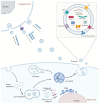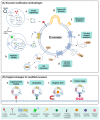Exosome-Based Carrier for RNA Delivery: Progress and Challenges
- PMID: 36839920
- PMCID: PMC9964211
- DOI: 10.3390/pharmaceutics15020598
Exosome-Based Carrier for RNA Delivery: Progress and Challenges
Abstract
In the last few decades, RNA-based drugs have emerged as a promising candidate to specifically target and modulate disease-relevant genes to cure genetic defects. The key to applying RNA therapy in clinical trials is developing safe and effective delivery systems. Exosomes have been exploited as a promising vehicle for drug delivery due to their nanoscale size, high stability, high biocompatibility, and low immunogenicity. We reviewed and summarized the progress in the strategy and application of exosome-mediated RNA therapy. The challenges of exosomes as a carrier for RNA drug delivery are also elucidated in this article. RNA molecules can be loaded into exosomes and then delivered to targeted cells or tissues via various biochemical or physical approaches. So far, exosome-mediated RNA therapy has shown potential in the treatment of cancer, central nervous system disorders, COVID-19, and other diseases. To further exploit the potential of exosomes for RNA delivery, more efforts should be made to overcome both technological and logistic problems.
Keywords: RNA loading; RNA therapy; challenges; drug delivery; exosomes; progress; targeting.
Conflict of interest statement
The authors declare no conflict of interest.
Figures


Similar articles
-
Exosomes multifunctional roles in HIV-1: insight into the immune regulation, vaccine development and current progress in delivery system.Front Immunol. 2023 Oct 27;14:1249133. doi: 10.3389/fimmu.2023.1249133. eCollection 2023. Front Immunol. 2023. PMID: 37965312 Free PMC article. Review.
-
Exosome as a Novel Shuttle for Delivery of Therapeutics across Biological Barriers.Mol Pharm. 2019 Jan 7;16(1):24-40. doi: 10.1021/acs.molpharmaceut.8b00901. Epub 2018 Dec 18. Mol Pharm. 2019. PMID: 30513203 Review.
-
Research Progress in Exosome-Based Nanoscale Drug Carriers in Tumor Therapies.Front Oncol. 2022 Jun 21;12:919279. doi: 10.3389/fonc.2022.919279. eCollection 2022. Front Oncol. 2022. PMID: 35800056 Free PMC article. Review.
-
Recent advances in exosome-mediated nucleic acid delivery for cancer therapy.J Nanobiotechnology. 2022 Jun 14;20(1):279. doi: 10.1186/s12951-022-01472-z. J Nanobiotechnology. 2022. PMID: 35701788 Free PMC article. Review.
-
Targeted therapeutic delivery using engineered exosomes and its applications in cardiovascular diseases.Gene. 2016 Jan 10;575(2 Pt 2):377-384. doi: 10.1016/j.gene.2015.08.067. Epub 2015 Sep 2. Gene. 2016. PMID: 26341056 Review.
Cited by
-
Exosomal circRNAs in gastrointestinal cancer: Role in occurrence, development, diagnosis and clinical application (Review).Oncol Rep. 2024 Feb;51(2):19. doi: 10.3892/or.2023.8678. Epub 2023 Dec 15. Oncol Rep. 2024. PMID: 38099408 Free PMC article. Review.
-
Exosomal noncoding RNA: A potential therapy for retinal vascular diseases.Mol Ther Nucleic Acids. 2024 Jan 24;35(1):102128. doi: 10.1016/j.omtn.2024.102128. eCollection 2024 Mar 12. Mol Ther Nucleic Acids. 2024. PMID: 38356865 Free PMC article. Review.
-
Regulation of Macrophage Polarization in Allergy by Noncoding RNAs.Noncoding RNA. 2023 Dec 11;9(6):75. doi: 10.3390/ncrna9060075. Noncoding RNA. 2023. PMID: 38133209 Free PMC article. Review.
-
RNA therapeutics in targeting G protein-coupled receptors: Recent advances and challenges.Mol Ther Nucleic Acids. 2024 Apr 24;35(2):102195. doi: 10.1016/j.omtn.2024.102195. eCollection 2024 Jun 11. Mol Ther Nucleic Acids. 2024. PMID: 38741614 Free PMC article. Review.
-
Exosome-based drug delivery systems for enhanced neurological therapeutics.Drug Deliv Transl Res. 2025 Apr;15(4):1121-1138. doi: 10.1007/s13346-024-01710-x. Epub 2024 Sep 26. Drug Deliv Transl Res. 2025. PMID: 39325272 Review.
References
Publication types
Grants and funding
LinkOut - more resources
Full Text Sources
Other Literature Sources

